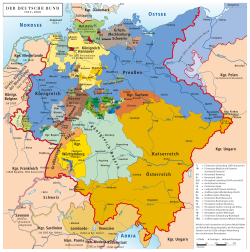
Back Duitse Bond AF Þēodisc Āþbēorscipe ANG الاتحاد الألماني Arabic Confederación Xermánica AST Almaniya ittifaqı AZ آلمان کونفدراسیونو AZB Германскі саюз BE Германски съюз Bulgarian Kengevread alaman BR Confederació Germànica Catalan
The German Confederation (German: Deutscher Bund [ˌdɔʏtʃɐ ˈbʊnt] ⓘ) was an association of 39 predominantly German-speaking sovereign states in Central Europe.[a] It was created by the Congress of Vienna in 1815 as a replacement of the former Holy Roman Empire, which had been dissolved in 1806 as a result of the Napoleonic Wars.
The Confederation had only one organ, the Bundesversammlung, or Federal Convention (also Federal Assembly or Confederate Diet). The Convention consisted of the representatives of the member states. The most important issues had to be decided on unanimously. The Convention was presided over by the representative of Austria. This was a formality, however, as the Confederation did not have a head of state, since it was not a state.
The Confederation, on the one hand, was a strong alliance between its member states because federal law was superior to state law (the decisions of the Federal Convention were binding for the member states).[2] Additionally, the Confederation had been established for eternity and was impossible to dissolve (legally), with no member states being able to leave it and no new member being able to join without universal consent in the Federal Convention. On the other hand, the Confederation was weakened by its very structure and member states, partly because the most important decisions in the Federal Convention required unanimity and the purpose of the Confederation was limited to only security matters.[3] On top of that, the functioning of the Confederation depended on the cooperation of the two most populous member states, Austria and Prussia which in reality were often in opposition.
The German revolutions of 1848–1849, motivated by liberal, democratic, socialist, and nationalist sentiments, attempted to transform the Confederation into a unified German federal state with a liberal constitution (usually called the Frankfurt Constitution in English). The Federal Convention was dissolved on 12 July 1848, but was re-established in 1850 after the revolution was crushed by Austria, Prussia, and other states.[4]
The Confederation was finally dissolved after the victory of the Kingdom of Prussia in the Seven Weeks' War over the Austrian Empire in 1866. The dispute over which had the inherent right to rule German lands ended in favour of Prussia, leading to the creation of the North German Confederation under Prussian leadership in 1867, to which the eastern portions of the Kingdom of Prussia were added. A number of South German states remained independent until they joined the North German Confederation, which was renamed and proclaimed as the "German Empire" in 1871, as the unified Germany (aside from Austria) with the Prussian king as emperor (Kaiser) after the victory over French Emperor Napoleon III in the Franco-Prussian War of 1870.


Most historians have judged the Confederation to have been weak and ineffective, as well as an obstacle to the creation of a German nation-state.[5] This weakness was part of its design, as the European Great Powers, including Prussia and especially Austria, did not want it to become a nation-state. However, the Confederation was not a 'loose' tie between the German states, as it was impossible to leave the Confederation, and as Confederation law stood above the law of the aligned states. The constitutional weakness of the Confederation lay in the principle of unanimity in the Diet and the limits of the Confederation's scope: it was essentially a military alliance to defend Germany against external attacks and internal riots. Ironically, the War of 1866 proved its ineffectiveness, as it was unable to combine the federal troops in order to fight the Prussian secession.[6]
- ^ Winfried Klein (14 September 2012). "Wer sind wir, und was wollen wir dazu singen?". FAZ.NET. Frankfurter Allgemeine Zeitung. Retrieved 4 August 2022.
- ^ Ernst Rudolf Huber: Deutsche Verfassungsgeschichte seit 1789. Vol. I: Reform und Restauration 1789 bis 1830. 2nd ed., Verlag W. Kohlhammer, Stuttgart [et al.] 1967, pp. 601/602.
- ^ Ernst Rudolf Huber: Deutsche Verfassungsgeschichte seit 1789. Vol. I: Reform und Restauration 1789 bis 1830. 2nd ed., Verlag W. Kohlhammer, Stuttgart [et al.] 1967, pp. 594/595.
- ^ Deutsche Geschichte 1848/49 Archived 18 October 2007 at the Wayback Machine, Meyers Konversationslexikon 1885–1892
- ^ Lee, Loyd E. (1985). "The German Confederation and the Consolidation of State Power in the South German States, 1815–1848". Consortium on Revolutionary Europe, 1750–1850: Proceedings. 15: 332–346. ISSN 0093-2574.
- ^ Ernst Rudolf Huber: Deutsche Verfassungsgeschichte seit 1789. Band III: Bismarck und das Reich. 3rd ed., W. Kohlhammer, Stuttgart 1988, pp. 559/560.
Cite error: There are <ref group=lower-alpha> tags or {{efn}} templates on this page, but the references will not show without a {{reflist|group=lower-alpha}} template or {{notelist}} template (see the help page).


